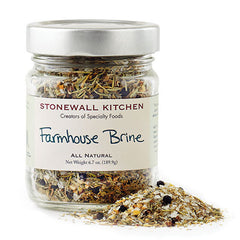T-minus 2 weeks until Thanksgiving, and you’re no doubt thinking about how you can top last year’s feast (or at least avoid setting off the fire alarm). We are, too. And we’ve been hearing a lot about BRINING.
There are as many ways to prepare a Thanksgiving turkey as there are stars in the sky, but one method that has gotten a LOT of buzz over the past few years is brining. So.. uh, what the heck IS brining? We're glad you asked.

What Brining Actually Is
Wet brining is soaking meat (typically leaner meats like chicken or your Thanksgiving turkey) in a “brine” (a salt-water solution that can [but doesn't HAVE TO] contain yummy herbs & spices) for an extended period of time, usually over night.
Dry brining is rubbing that salt and those herbs & spices directly to the skin of your meat without water.
And then science takes over.

Science Does What to My Turkey?
Did you know that meat loses about 30% of its moisture during cooking? When heat meets your turkey, the individual coiled muscle fibers unwind (“denature”, if you want to get Real Science-y) and then join together, which, as you can imagine, causes a little bit (or a lotta bit) of shrinkage. That shrinkage is why your meat gets tough, rubber-y, and just.. well. Sorry, Aunt Helen, but your turkey tastes like a pencil eraser.
When you brine your turkey, you allow the muscle fibers of your turkey to absorb liquid. Brined meats typically weigh 6 to 8% more than they did pre-brine, and though some of this liquid gets lost during the cooking process, it retains more juice by virtue of having more juice at the start.
But That’s Not All
Most importantly, though, the salt present in your brine causes the muscle fibers in your meat to unwind, swell, and trap water between the fibers. More places to trap water = juicier, more delicious turkey. Yeah, even the turkey breast. The spices in your brine will help flavor your turkey. Think of it like a marinade.. just.. saltier. And more science-y.
Um, Won’t My Turkey Be Too Salty?
No. Brine recipes are unbelievably specific—the salt content is just right (usually around 5-8% salt) to do the good stuff to your turkey. Follow the recipe (we know you will) and you’re good to go.
Get Your Brine On
Brining is super easy. All you need is a brining bag and a brine (and, duh, a turkey).
For brining beginners? We recommend using a pre-made brine that will have the perfect ratio of spices and herbs. We love Stonewall Kitchen Farmhouse Brine, available in store or online:
If you’re a SEASONED pro (see what we did there), try one of these brine recipes:
- 6 Easy Brine Recipes (Real Simple)
- Deep Fried Turkey Brined in Cayenne and Brown Sugar (Food & Wine)
- Honey Brined Turkey (Bon Appetit)
If you'd like to give dry brining a whirl:
Go Forth and Brine, Grasshopper
We're pretty sure we've convinced you to brine this year's bird, but if you're still skeptical, feel free to shoot us an email (info@eggshellskitchencompany.com) or contact us for answers to all your Burning Brining Questions.
Want to make sure your kitchen is ready for roasting? Check out our post on Thanksgiving Roasting Essentials!

